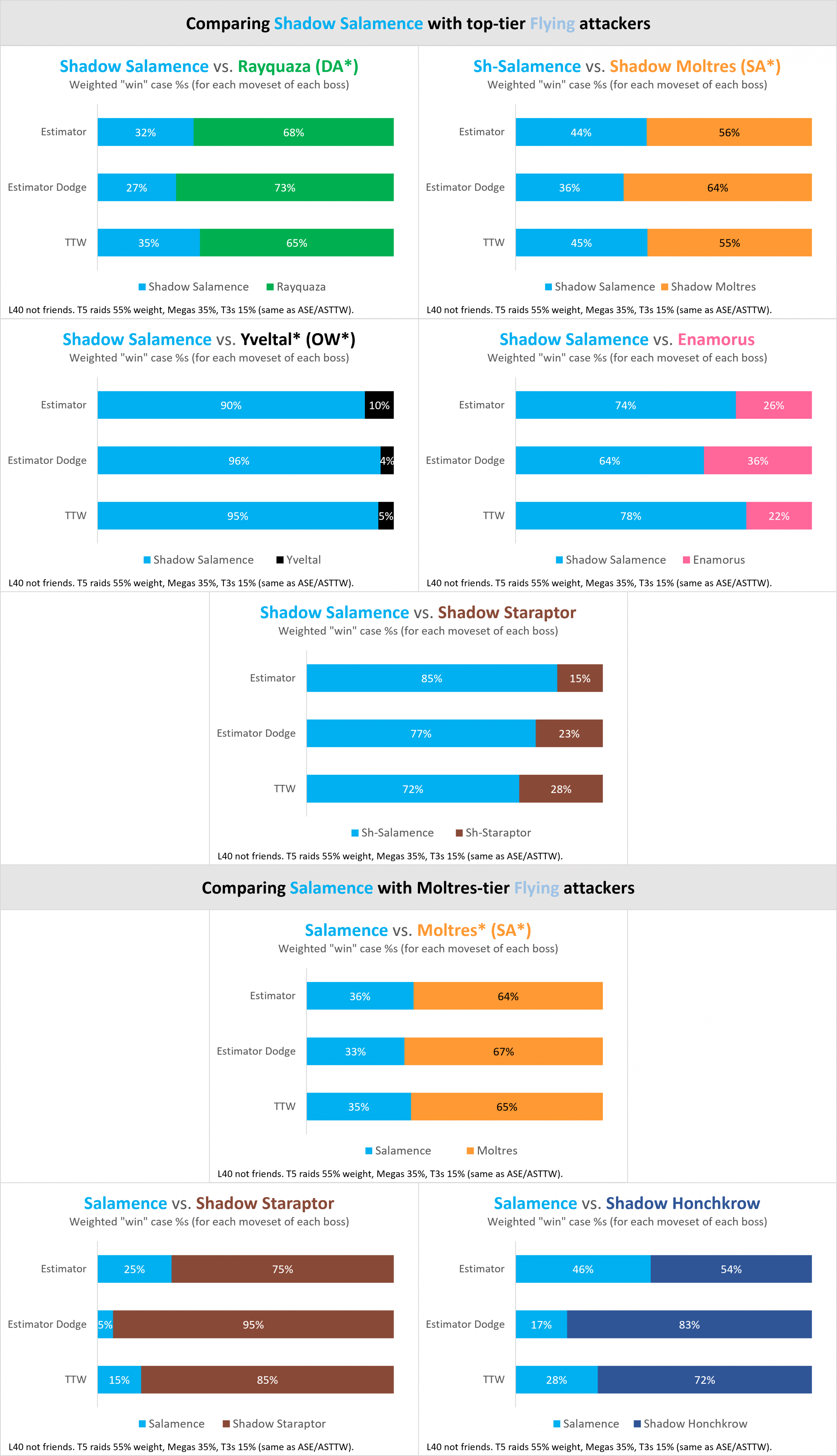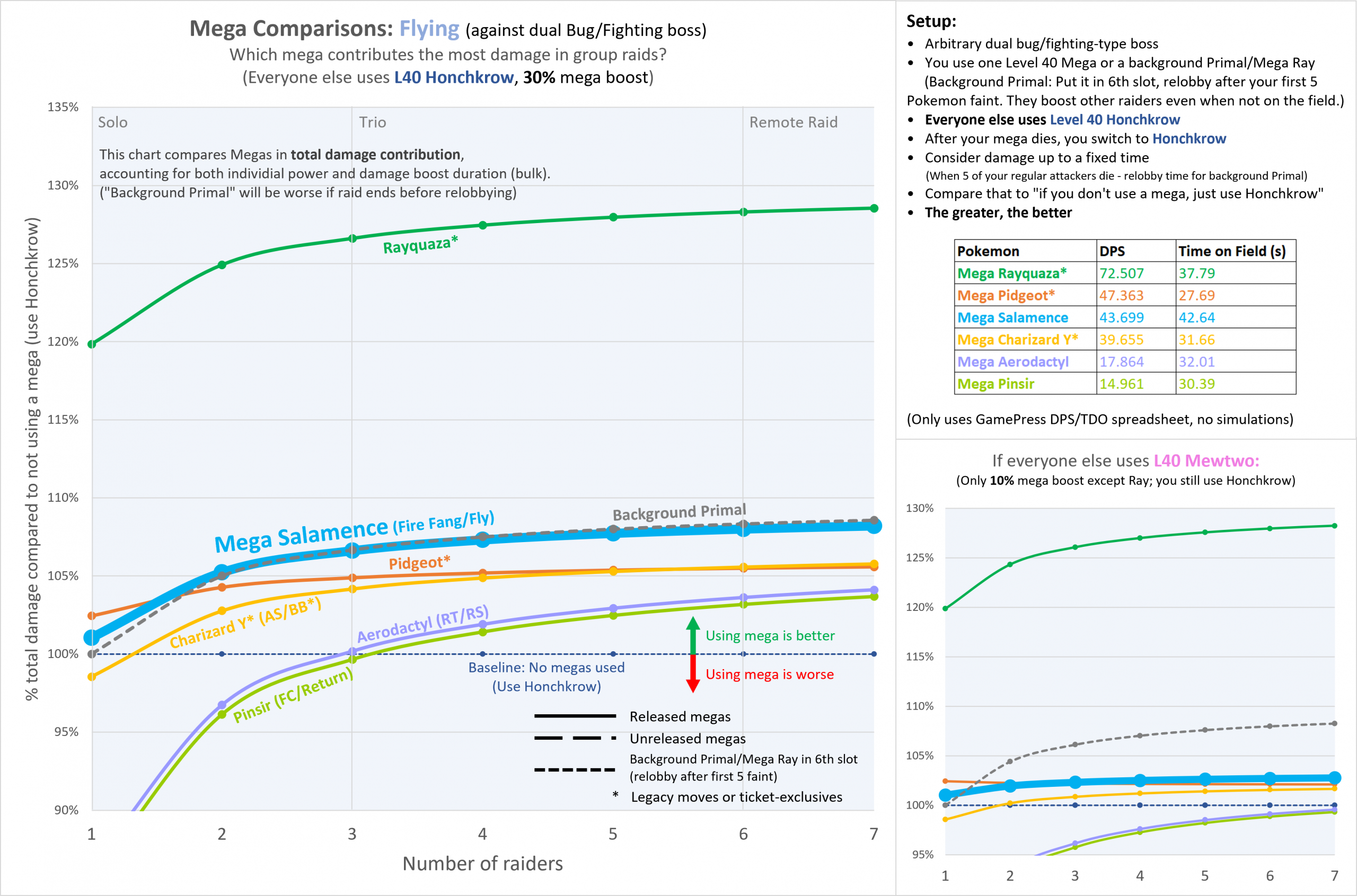This analysis is for a moveset change that already happened on June 1st. It is not a recent or upcoming event, and there’s no rush in getting Fly on your Salamence.
I’m sorry for my absence this season. The charts were mostly done in early June, but I was subsequently away for most of June and July for personal reasons.
Main Points (TL;DR)
Fly Salamence is essentially a clone of Sky Attack Moltres in all its forms, and achieves a great balance between cost and performance among flying attackers. If you have any Salamence built as dragon attackers, adding Fly as a second move is highly valuable.
- Shadow Salamence is a near-top non-mega flying attacker. The only better ones are (all forms of) Dragon Ascent Rayquaza, and Shadow Moltres (slightly). It outshines everything else.
- Regular Salamence is the best non-legendary regular flying attacker, significantly above Staraptor et al. Although it’s consistently behind top legendaries (Ray, Yveltal, Enamorus) and shadows (Shadow Moltres, Fly Staraptor, arguably even Honchkrow), Salamence is likely cheaper and more common than all of these.
- Mega Salamence is technically the #2 flying-type mega. That’s not as enticing of a title in practice as it may sound, but it’s still an excellent option for those without Mega Rayquaza.
Brief words about possible (speculative) Bleakwind Storm Tornadus-I at the end of the article.
My analyses of other types are in this spreadsheet. You can also follow me on Twitter (X) and Threads!
Charts
Flying Attackers, in General

Comparisons

Flying Megas

Speculation: Air Slash Salamence

Salamence’s Fast Moves, and How They Stack Up Against Different Bosses
[TL;DR] Fire Fang whenever the boss is partly Grass or Bug, Dragon Tail otherwise.
Fly is an overpowered charged move, and with Salamence’s high base attack, its potential could have been even higher. The reason why that’s not the case is the lack of a flying fast move. However, that didn’t become a big limiting factor after all — Dragon Tail is good enough, and Fire Fang partially makes up for the typing disadvantage, even with some theoretical surprises.
Fire and Flying types heavily overlap on the offensive end (which is part of what makes Moltres great). Specifically, Flying attacks are super effective against Grass, Bug and Fighting, and the first two are also weak to Fire.
This means we can put all potential bosses into three categories:
- Fighting-type bosses (that are not also Grass or Bug types), such as Zamazenta and Mega Mewtwo X. Against these, Salamence prefers Dragon Tail, and is does worse in fast move super effectiveness than other flying attackers.
- Dual-type Grass/Fighting and Bug/Fighting bosses, such as Virizion, Buzzwole and Mega Heracross. Against these, Salamence prefers Fire Fang, which gets a 1.6x damage multiplier to Dragon Tail’s 1.0x. However, it’s still disadvantaged compared to other flying attackers, whose fast moves like Air Slash have 2.56x super effectiveness multipliers.
- Grass and/or Bug bosses (that are not also Fighting types). Salamence still prefers Fire Fang, but this time it fares much better than #2: both Fire Fang and flying-type fast moves are equally super effective (1.6x) against the boss. Fire Fang still misses out on a STAB multiplier of 1.2x (as Salamence is not a fire-type Pokemon), but that’s a much smaller price to pay.
However, the three categories are not created equal:
- Frequency in T4+ raids: #2 > #1 >>>> #3
- Grass and Bug-type bosses are almost non-existent in higher raid tiers. The only “surefire” future T5 is Ogerpon (Gen 9 DLC, good luck waiting).
- Also note that #2 makes flying attackers compulsory, whereas #1 bosses often have alternatives, such as Mewtwo.
- Salamence’s relative performance: #3 >> #1 > #2
- For the much more common #1 and #2, Salamence’s ranking is similar to what my charts and TL;DR show (with a caveat below).
- For the rare #3, Salamence is greatly elevated. Shadow Salamence is even better than regular Rayquaza, while regular Salamence is slightly above Yveltal. (It’s very similar to what the Air Slash speculative charts show.)
Due to its low frequency, #3 is more of an intellectual curiosity and you’re unlikely to encounter such scenarios in practice (unless you do Tier 3 raids). However, that doesn’t alter the analysis, since everything you’ve read so far is predominantly determined by #1 and #2.
Caveat: Moltres vs. Salamence (Beyond the Chart)
For #2 bosses (Grass/Fighting and Bug/Fighting) in particular, Moltres (and its shadow) comes ahead of corresponding Salamence forms rather significantly on average.
- It doesn’t seem like Salamence is underperforming, but rather, Moltres is overperforming thanks to typing advantage when facing Grass and Bug-type attacks.
- For this reason, I’d still rank Moltres above Salamence holistically, especially in light of #2 being the primary use case of flying attackers for many players.
- However, Salamence definitely has its typing advantages at times, such as against Stone Edge Virizion (especially for the shadow attackers) and Rock Blast Mega Heracross. I’d even say Salamence may be a more reliable option, whereas Moltres is “high risk, high reward”.
Quick Note on Mega Salamence
Mega Salamence gained just as much from Fly as the regular and shadow forms. In terms of solo performance, it’s very close to Shadow Salamence, just like the case as dragon attackers. The mega actually has much lower DPS than the shadow, but its vastly better bulk makes up for it. Regardless, it’s still technically the #2 flying-type mega (only behind Mega Rayquaza), and a top-tier flying attacker in general.
But you might have noticed I’ve not discussed Mega Salamence as favorably as its other forms. This is because:
- Flying-type megas have virtually no competition to begin with. Half of the flying-type megas don’t even have any flying-type charged moves, and besides the impeccable Mega Ray, the only real competition is from… Mega Pidgeot. In essence, Mega Salamence’s ranking is more due to lack of alternatives, and not because it delivers over-the-top performance (that you typically think of when discussing megas).
- For those with a Mega Rayquaza (that’s not on cooldown), it’s simply miles better. In addition to 50% better performance (!!), Mega Ray also provides a group damage boost during virtually the entire raid (the “background boost”), while Mega Salamence only does so when it’s on the field. Ray even has greater candy-boosting capabilities.
- The elephant in the room for all megas: The “background primal boost” greatly reduced the value of a large number of them. For those that lack a Mega Ray but do have a Primal Kyogre or Groudon, putting it in the 6th slot during a group raid — without actually doing damage — contributes just as much damage as Mega Salamence does.
- This is as much of a positive point for Mega Salamence as a negative one, though. Most megas of other types become inferior to a background primal in 6-man lobbies (see recent discussion of Mega Heracross), whereas Mega Salamence has enough bulk and raw power to virtually overlap with background primals on the chart.
Regardless — and I’ll make this very clear — for those without a Mega Rayquaza (or on cooldown), Mega Salamence remains an excellent option. It will most likely be the best pick for one of your 6 attackers, whether in a solo or group raid, and whether replacing a Yveltal, Staraptor, Mega Pidgeot, or possibly even Shadow Salamence/Moltres.
- I myself would strongly advise against purifying a Shadow Salamence just to mega evolve it, however.
Speculation: Air Slash Salamence
Salamence doesn’t have a flying-type fast move in PoGo now… But could it learn one?
In theory, yes. In the main series games, Salamence can learn Air Slash with a TM. This means Niantic is allowed to give it Air Slash in PoGo if they want to, so it may possibly be part of another Go Battle League movepool update at the start of a future season.
Hypothetical Air Slash would improve Salamence even further, by a lot. As shown in the final chart:
- Shadow Salamence would become even better than regular Dragon Ascent Rayquaza. (Comparing to Shadow Rayquaza would be a lost course, though, but that’s also much less accessible than Shadow Salamence.)
- Regular Salamence would become the #2 regular flying attacker, essentially tied with Oblivion Wing Yveltal.
- (Of course, Mega Salamence also improves, though still far from Mega Rayquaza.)
However, all of this is pure speculation. There’s no indication that Niantic will (or will not) give Air Slash to Salamence, and it may jolly well never happen. But we can hope.
Speculation-ish: Bleakwind Storm Tornadus-Incarnate
This section has become very uninteresting following Fly Salamence, but I’ll give it a quick mention given Tornadus-I’s imminent return to raids.
Context: Tornadus Therian (the bird form) had already received its raid-exclusive signature move, Bleakwind Storm, earlier this year. Its Incarnate form (the standing form) will return to raids very soon on July 23, but there’s no info on whether it will come with Bleakwind Storm this time. It could happen, but we don’t know.
Bleakwind Storm Tornadus-I is virtually identical to the Therian form on the chart, or ever so slightly ahead. The Incarnate form has slightly higher attack (thus higher DPS), but is glassier. (I stupidly forgot to plot BS Tornadus-I this time, but you can see it on the chart in a previous analysis.)
However, neither Tornadus forms is worth the cost in most cases. Their performances are very similar to Staraptor and Braviary, and now behind Fly Salamence, none of which require legendary candy and/or Elite TMs. And if you’re willing to spend these premium resources, many other legendaries and shadows perform much better.
Upcoming articles
Mega Lucario analysis coming next week, of course. I also do plan to finish the “Go Fest speculation” analysis that I mentioned in the last article, with a focus on the likes of Ultra Necrozma, Marshadow, and other fusion forms.
Imgur Links and Additional Charts
General attacker charts: ASE and ASTTW*
Comparisons:
Mega charts:
* indicates additional charts that are not in the main post.

Recent Comments